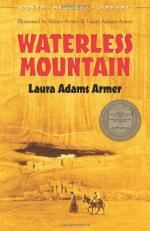|
This section contains 229 words (approx. 1 page at 300 words per page) |

|
Waterless Mountain takes place in the 1920s, a time that coincides with the author's visits among Arizona's Navajo people. The Navajo, as well as the other Native American tribes, have clashed culturally with the white world and have suffered from these clashes. In Waterless Mountain, for example, Armer alludes to the Navajo's "Long March" of the 1860s, when the United States government exiled them to Fort Sumner, an ordeal related in Ruth Roessel's Navajo Stories of the Long Walk Period and in Scott O'Dell's novel Sing Down the Moon. Armer's main purpose, however, is to detail the simple pleasures of Navajo daily life, especially their close bonds with the land itself. Armer also alludes to twentieth-century inventions that intrude upon the Navajo way of life: the airplane, the automobile, and the steam locomotive. Even the segment in which Younger Brother and the white boy join each other hints...
|
This section contains 229 words (approx. 1 page at 300 words per page) |

|




